Of all the accessories you can invest in for your bass guitar, a tuner pedal remains one of the most important of all. As a matter of fact, it should be the first thing to get after getting a bass guitar.
There is nothing as disastrous and terrible as an out-of-tune bass guitar. Considering the very important role of the bass in any band, it is almost unforgivable and unmanageable to play a detuned bass guitar.
Although some players with awesome ears can always try to rely on their ears, the truth is that you can seldom do it as a tuner would do—when it comes to tuning your bass guitar. There are three categories of tuners for bass.
There are clip-on tuners, smartphone app tuners, and tuner pedals. Although the first two work quite amazingly, they still, however, do not work as perfectly as tuner pedals.
The problem with clip-on and smartphone tuners is that external sounds can easily interfere with the tuning process because of how they work. Smartphone tuners simply use your phone’s microphone to detect the pitch and then analyze if it is in or out of tune.
This sounds cool, but it also means that if another sound, for instance, the crazy loud drummer should play while you are trying to tune, then the tuner will not work as fine as it should. They are prone to external sounds.
The clip-on tuner works better than that as it is clipped to the headstock of your bass. This way, it senses the vibration of the entire bass guitar once a note is being played. This is better than smartphone tuners, but it is still prone to external sound interference.
The best of it all is the tuner pedal. The tuner pedal works by plugging your bass guitar into the pedal with your instrument cable. The pedal will then identify the electrical signal coming in through the bass’ cable as a pitch.
It then displays that pitch on its screen/display. This is the most accurate and reliable tuning method as there is no external interference that will ruin your tuning process, unlike the other two types of tuners.
In this article, we will discuss and take a look at 15 amazing tuner pedals that you can get for your bass guitar. It doesn’t matter if you are a beginner bass player or a seasoned pro, all you have to do is read on and find out!
Table of Contents
15 Best Tuner Pedals for Bass
- The GOGO Chromatic Tuner Pedal
- JOYO JF-18 Power Tune Chromatic Tuner and Power Bank
- KLIQ TinyTune Chromatic Tuner
- Valeton CTU-1 Coral Tuner
- Monoprice Chromatic Tuner
- GuitarX X9 Chromatic Tuner Pedal
- Behringer TU300 Chromatic Tuner Pedal
- Korg Pitchblack Advance Chromatic Tuner
- Boss TU-3 Chromatic Tuner
- Ibanez BigMini Chromatic Tuner
- Peterson StroboStomp HD
- Donner DT-1 Chromatic Tuner Pedal
- TC Electronic PolyTune 3
- Blaxx BX-Tuner Pedal
- Vox VXT-1 Strobe Pedal Tuner
Review of 15 Best Tuner Pedals for Bass
Buying a pedal tuner can be confusing. There are lots of different models out there and even many different types of pedal tuners that you can invest in. Here is a detailed review of each of the 15 pedal tuners that we rounded up.
The GOGO Chromatic Tuner Pedal
If you want a no-frills tuner, then the chromatic pedal from GOGO will be a fantastic choice. This tuner does precisely what it is built for without any unnecessary fuss or fancy features.
Moreover, this is a great tuner for someone who wants to add a tuner to their pedal board and especially for performers who want to have a pedal on the side that they can refer to while they play.
The main highlight of this tuner is the large screen. Nearly the whole front face of the device is the screen which means very good visibility even if the tuner is placed far away from you.
Moreover, the tuner also features a 9V output which will allow you to chain together different pedals on your board. The pedal has a bright orange colour which makes it easily recognizable in a pedal board and it is built very well featuring a completely aluminium body.
The chromatic tuner itself features a +/- 0.5 per cent sensitivity which yields extremely accurate tunings. This pedal can either be powered directly by a 9V AC connection or through a 9V battery pack which makes it great for those who need portability.
At a very reasonable price, you get an excellent tuner that is also very durable. This is a great buy for any kind of musician. However, their only drawback is that if you want advanced features like drop tuning or adjustable settings, you will have to look elsewhere.
Here is a good video review of the GOGO chromatic pedal.
| Pros | Cons |
| Excellent price | A bit large and clunky for those that need portability |
| Highly accurate tuner | Lacks custom tuning features |
| Very durable and well built |
JOYO JF-18 Power Tune Chromatic Tuner and Power Bank

For those musicians that love having all their pedals up and working when they start to jam, the JOYO JF-18 will be a dream come true. While this is a chromatic pedal tuner it also doubles as a DC power bank for other pedals.
If you are looking for a tuner for your pedal board and you are also struggling with power connections, this will solve all your problems. As a power bank, this pedal gives you 9 DC output ports with a total output capability of 1600mA.
6 of these ports provide 100mA of power while two ports are capable of providing 500mA. These high-power ports will be far more than enough even for the most demanding effect pedals.
You can easily chain together all the pedals you need with this tuner and get all the effects you want while staying in tune. As a tuner, this device also performs quite well. It features a true bypass switch which will keep your signal crystal clean while playing and tuning.
Moreover, the power output ports on the device are also filtered and low-noise output ports which also minimize distortion, buzzing, humming or any other undesirable sounds while playing.
The chromatic tuner in this device boasts a +/- 1 per cent efficiency which yields good tuning results. Moreover, it features a large and bright LED display which makes tuning a breeze.
Overall, the tuner is easy to use and quite straightforward. Just connect the power cable and the audio in the jack and the tuner will come on display in whatever note it senses. Then you can tune accordingly.
Here is a detailed video about the JOYO JF-18 power tune.
| Pros | Cons |
| Good tuning capabilities | 8 output ports can be overkill for some users (it also increases the size and weight of the device) |
| Excellent power options for a multiple-pedal setup | No battery power option |
| Good filtration to limit cross-talk | Pricey |
KLIQ TinyTune Chromatic Tuner
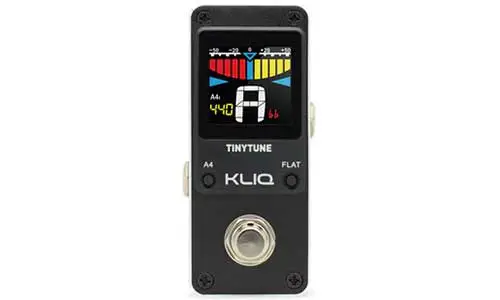
The most popular product by KLIQ is the UberTuner which is a clip-on style tuner. Recently, the company has come out with its first pedal-style tuner in the form of TinyTune.
As the name implies, this pedal tuner is much smaller than most other pedal tuners you will find on the market but it certainly does not compromise on performance. KLIQ produces some great quality products at very affordable prices and the TinyTune is no different.
The front of this device sports a decent-sized LED screen that is nice and bright giving you good visibility in both dark and bright environments. While this is a basic tuner, it does give you some room for flexibility.
On the front of the device, you will notice two buttons other than the main aluminium centre button. The button on the right labelled ‘flat’ allows you to tune flat up to 4 semitones below standard pitch.
The button on the left labelled ‘A4’ allows you to adjust your reference frequency between 430 Hz and 450 Hz. The tuner itself has an accuracy of +/- 0.5 per cent and it is quite quick and responsive in performance.
This tuner features a true bypass footswitch and once it’s on it will also mute output so you can tune in silence. It can be powered by a 9V 24mA PSU or a 9V battery. Given its small size, a single battery can last quite a while in this device.
Here is a good video about the KLIQ TinyTune.
| Pros | Cons |
| High accuracy tuner | Lacks advanced features |
| Small and portable | Lacks connectivity to other pedals |
| Versatile in functionality |
Valeton CTU-1 Coral Tuner
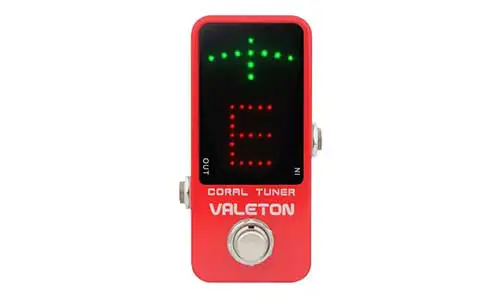
Another good pedal to consider if you are looking for a mini-sized tuner is the CTU-1 by Valeton. This product features an all-aluminium build, a small size, low power requirements and good tuning capability.
The chromatic tuner in this product has an accuracy of +/- 2 per cent. This is slightly lower than other models in this list but this is still well below what the human ear can detect and will yield good results in a real-world setting.
The display is a decent size with a bright light. Due to the smaller size of its body, the display is not as large as what you would find on other models but for a travel-friendly pedal tuner, it is large enough.
It also has a true bypass footswitch so you can be sure you aren’t losing any quality when it is not in operation.
While this tuner does lack in accuracy it makes up for it with a very wide range of frequency detection. This makes it particularly good for bass guitars and even for those players that want to go deeper on bass or regular guitar.
In terms of power, this pedal tuner can work with both a PSU and a 9V battery.
Here is a video on the Valeton coral tuner.
| Pros | Cons |
| Easy to setup and use | Not as accurate as similarly priced alternatives |
| Wide frequency response range |
Monoprice Chromatic Tuner
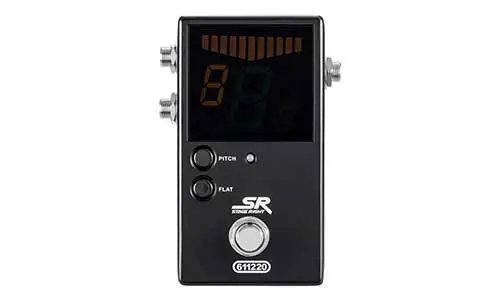
If you see the Monoprice tuner in the Monoprice uniform, you could save quite a bit of money. This particular tuner is often branded under other titles and then sold for a higher premium.
However, the hardware remains the same and it is most economical under the Monoprice brand. Considering that other brands often rebrand this tuner says something about the quality that you can expect from this product.
A lot of people pay too much attention to the accuracy of the tuner. The Monoprice offers a +/- 1 per cent accuracy, which may be less than others but is good enough for most players. Moreover, the tuner makes up for this in other departments.
Upon examination, you will notice that this tuner has two output ports. This is for good reason. The first is the true bypass output which will be muted when the pedal is tuning. The other allows throughput while playing which means you can tune while you play.
Additionally, this tuner also offers flexibility in terms of tuning frequency. With the Monoprice, you can select your frequency between 436 Hz and 445 Hz. If you tend to play with other instruments, particularly acoustic ones, this is going to come in handy.
In terms of power, this tuner can work with a 9V battery or a PSU. Here is a video on the Monoprice chromatic tuner.
| Pros | Cons |
| Very responsive when tuning | Does Not allow daisy-chaining pedals |
| Offers both true bypass and live tuning features |
GuitarX X9 Chromatic Tuner Pedal
GuitarX has covered nearly all possible user requirements with its X9 tuner. This tuner gives you a wide range of functionality without breaking the bank and it delivers some pretty good performance too.
In terms of accuracy, this tuner gives you +/- 0.5 per cent which is up there with some far more expensive products from bigger brands. More importantly, not only is it accurate but it also gives you a wide frequency response range.
The X9 can easily detect even a low B string on extended bass guitars and will also work well for deep bass on regular guitars. For a bass player who wants to go as deep as possible, this is a great tuner to get.
The LED panel looks a bit like a Korg tuner though it gives you 9 LEDs when tuning (as opposed to Korgs’ 11). This makes it very easy to fine-tune your strings and really get the right setting for the note you want.
Moreover, the X9 also gives you the option to tune according to 4 semitones below standard pitch and you can also adjust the tuning frequency between 435 Hz and 450 Hz. It features the true bypass footswitch and also mutes the output when in tuning mode.
| Pros | Cons |
| Good LED indicators make tuning a breeze | Not as snappy/sensitive as other pedal tuners |
| Adjustable features |
Behringer TU300 Chromatic Tuner Pedal
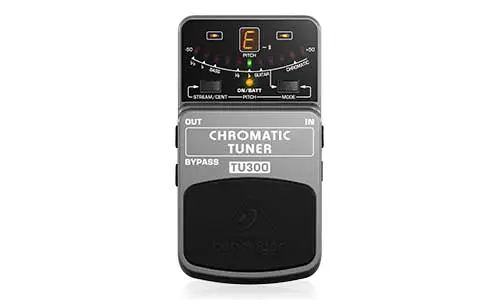
The TU300 tuner from Behringer brings together an interesting combination of features. This is the kind of tuner that you wouldn’t mind having among your equipment. It can either be something you rely on completely or it can serve as a backup tuner.
The most important characteristic of this tuner, and the thing that will make it a must-have for some musicians, is the multiple tuning modes. It has a total of 7 modes; 3 for guitar, 3 for bass and one for chromatic mode.
For bass, it offers three tuning modes which include regular, flat and double flat. Regular gives you the standard tuning at E, flat will tune it half a step down and double flat will tune it a full step down.
This is a budget-oriented tuner from Behringer and features the hard-plastic material that is also found on other budget Behringer tuners. In terms of accuracy, it has a +/- 1.5 per cent accuracy and works with either a PSU or a 9V battery.
Interestingly, this tuner is only offered with a buffered bypass. Again, this is something that some musicians will either love or hate. Overall, as a tuner, it performs well and also offers a few things that you won’t find in other products at this price level.
Here is a good video about the Behringer TU300.
| Pros | Cons |
| Offers multiple tuning modes | Not the most premium construction |
| Small and portable design | Can be a bit confusing for newbies |
Korg Pitchblack Advance Chromatic Tuner
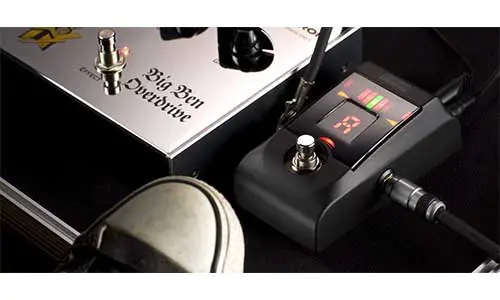
The Pitchblack Advance tuner by Korg is one of the most widely used, most well-respected and oldest tuners that is still in production and high in demand. For many, this is the benchmark for a pedal tuner against which all other tuners are compared.
Over the years, not much has changed with this pedal tuner since it is so good that there really is no need to change much. The ‘Advance’ model is the latest iteration of the Pitchblack pedal tuner.
In terms of accuracy, this tuner boasts an accuracy of +/- 0.1 per cent. It also features four tuning modes; regular, strobe, half-strobe and mirror. For the highest tuning accuracy, the best option is to use the Strobe setting.
This is a heavy-duty tuner meant to be used in all kinds of situations. It is built with an all-aluminium body and features a very bright LED panel on the front. The panel also has a few lines that will light up when you are tuning making it easier to tune accurately.
The face of the device just has the footswitch and at the top of the device, you will find the buttons used for selecting the tuning mode and calibration settings. This device is a true-bypass tuner and it also features a 9V (200mA) output so you can daisy chain other devices to it.
The Pitchblack advance will work either with a 9V PSU or a 9V battery.
Here is a good video about the Korg Pitchblack tuner.
| Pros | Cons |
| Extremely accurate tuner | Expensive |
| Tried and tested tuning pedal that has all the important features you could need | |
| High-quality build and components |
Boss TU-3 Chromatic Tuner
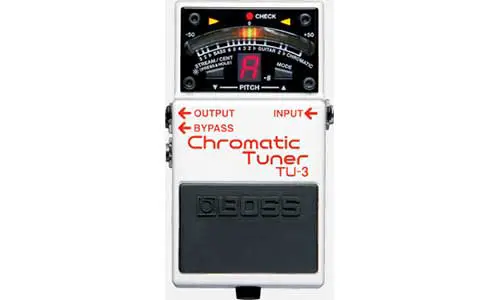
Boss is an iconic brand when it comes to tuner pedals. The latest tuner from Boss the TU-3 is an upgrade from the very well-known and highly regarded TU-2.
In fact, the TU-2 was the highest-selling chromatic tuner which is a testament to how popular this brand and this line of pedal tuners are. The TU-3 brings with it a few interesting upgrades that make it even more user-friendly as well as versatile.
In terms of tuning accuracy, this device has +/- 1 per cent accuracy. The biggest and most obvious change from the previous model is the screen which is now brighter and also features adjustable brightness modes. This makes it easy to use even under direct sunlight.
It also features an Accu-Pitch function which gives you a visual indication on screen when you are in tune. This makes tuning on the go very easy as you just have to keep an eye out for the notification rather than a change of colour (which can be hard to do in some lighting conditions).
Most importantly the TU-3 supports a very wide frequency range. Even the deepest basses can be tuned with this tuner whether you are using a guitar or a bass guitar with extended bass.
It also has a flat-tuning setting which supports up to six half steps so drop tuning is also very easy on this device.
This device features a 9V out as well as two ¼ outputs; one is a bypass while the other is unmuted.
Here is a good video about the Boss TU-3 tuner.
| Pros | Cons |
| Excellent build quality | Not as accurate |
| Excellent screen and brightness | Expensive |
| Versatile tuning functionality |
Ibanez BigMini Chromatic Tuner
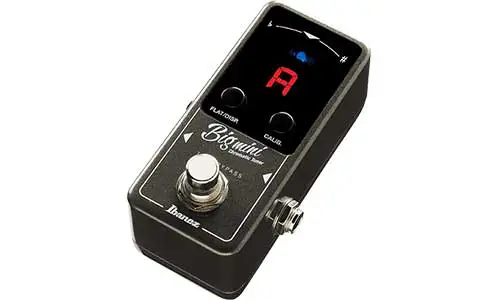
Ibanez is another very well-known brand that has been putting out quality products for decades. As the name suggests, the Big Mini is a compact pedal tuner by Ibanez that brings all the functionality you need into a much smaller pedal tuner.
It is made out of aluminium all around so it is very sturdy and also features a very nice 11-segment LED display.
The BigMini has two tuning modes; strobe and needle and the 11-segment LED certainly helps out. The LED display also shows the current note when tuning which is also helpful.
This tuner has an accuracy of +/- 1 per cent with a true bypass circuit. It also allows you to drop-tune up to 4 semitones through the ‘flat’ button on the top.
Being a super compact tuner, it barely draws any power at just 14mA through a 9V PSU or battery. This is a great tuner to have if you need one for your travel bag.
Here is a video about the BigMini tuner by Ibanez.
| Pros | Cons |
| Excellent build quality | Lacks advanced features |
| Great price |
Peterson StroboStomp HD
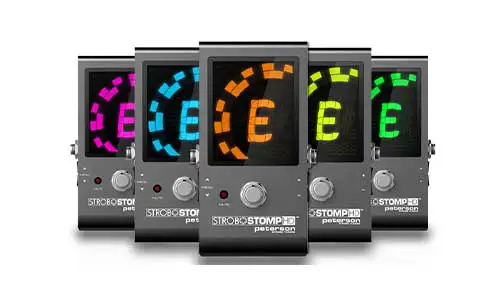
If you are in the market for a strobe-style tuner, then you can’t go wrong with the StroboStomp HD by Peterson. Peterson is very well-known for making strobe tuners and this is one of the few models that they have in a pedal format.
More importantly, the stroboStomp HD also has a few neat features that make it an exceptional performer. One of the best things about this tuner is that it is extremely accurate with an accuracy of +/- 0.1 per cent.
Also, this is a large tuner which also allows for a very large and bright LED screen. One unique feature of this screen is that it has customizable lighting. You can personalize the background color according to your taste, or specific lighting conditions.
It also features multiple bypass modes including true bypass, buffered bypass and monitored mode. In the monitored bypass mode, output is not muted.
Another very important feature of the StroboStomp HD is its high level of customization and tuning optimization.
This tuner comes with 135 sweetened tunings which allow you to perfectly tune an instrument by overcoming the minute differences and tonal problems in certain instruments. Moreover, this device also supports multiple tuning presets.
In fact, you can even order them according to which presets you use most frequently. Additionally, you can also assign different screen colours to different tuning presets. This makes it a lot easier to organize which tuning you are using on the go.
However, even with all these features, the device itself and the interface are very usable and very intuitive.
Here is a detailed video about the Peterson StroboStomp HD.
| Pros | Cons |
| Very high accuracy | Pricey |
| Plenty of functionality | |
| Excellent build quality |
Donner DT-1 Chromatic Tuner Pedal
If you are looking for a budget option that doesn’t compromise on performance, then Doner has you covered with the DT-1 tuner. This is a small tuner that packs some excellent performance and will suit a wide variety of musicians.
Given its size, it does have a small display screen but Donner has worked around this hurdle by also providing 3 LED lights. These are to indicate whether the string is flat, sharp or in tune.
The green LED in the centre will light up when the string is in tune while the other two red LEDs light up depending on whether you are sharp or flat.
This makes it much easier to tune your bass without actually having to look at the screen at all and comes in very handy if you are a little further away from the screen since you can tune your bass just by looking at the lights.
In terms of accuracy, this tuner will tune accurately to =/- 1 percent. Which isn’t that exceptional but it is still great for a portable tuner. Given that it is a chromatic tuner, there is a bit of flexibility in its tuning options.
However, this works best as a bass tuner when you are performing on stage or just as a good little tuner to have in your bag to take with you whenever you want. It can be powered through a wired connection or through a 9V battery.
Here is a good video about the DT-1 tuner.
| Pros | Cons |
| Very affordable | Not the most attractive or the most technically advanced tuner you can get |
| Sturdy and reliable |
TC Electronic PolyTune 3
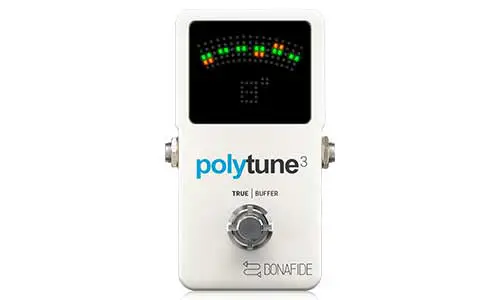
If you are looking for accuracy and versatility, then the PolyTune3 is another great option to explore. This relatively new company has taken the market by storm and a number of musicians rely on this very tuner to get their gear sounding right.
As the name suggests this is a chromatic tuner with polyphonic capabilities. In the polyphonic mode, you can strum all your strings together and start tuning. In the chromatic mode, you can take a more traditional approach and tune each string individually.
This is great if you are looking for some unique offset tuning for the entire guitar and it will also perform well if you need to tune an extended bass guitar.
You can also put this tuner into automatic mode and it will automatically shift between polyphonic and monophonic modes depending on how many strings you play.
In strobe mode, this tuner will yield an accuracy of =/- 0.2 per cent while in chromatic mode accuracy will drop slightly to +/- 0.5 per cent.
It has great internal components as well as excellent external build quality. Inside, you will find Bonafide Buffer circuitry which ensures you get a very clean signal no matter how long the wiring is and even through multiple other pedalboards that may be chained to this device.
It also features an ambient light detector which can automatically adjust the powerful LED display according to the ambient light in the environment for optimal viewing at all times.
Moreover, it gives you the option to either tune in bypass or tune in the always-on mode so you can watch your tuning as you play.
Here is a video about the PolyTune 3.
| Pros | Cons |
| Amazing build quality on the enclosure as well as internal components | There is a bit of a learning curve for new users |
| Great set of features that make this a perfect device for any kind of guitar or bass instrument | Pricey |
Blaxx BX-Tuner Pedal
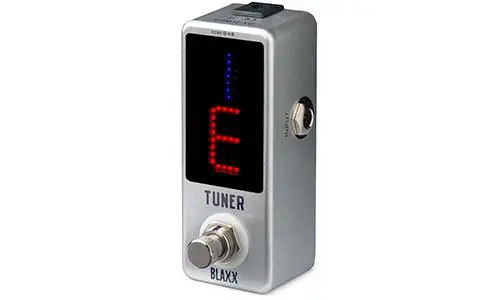
If you need something rugged and simple to get your tuning sorted out then this is a good device to consider. Built with a rugged die-cast metal body, you can be sure that this device can take a beating.
On the front panel, it features a small LCD screen along with three tuning LEDs. Two red LEDs to indicate flat and sharp notes and a green LED in the centre to indicate when you are in tune.
This is a bare-bone tuner and will give you excellent tuning results for both an electric guitar and a bass guitar. It is quite responsive and will easily pick up even extended bass frequencies.
It is powered by either a 9V PSU or a 9V battery and because of its low power requirements, it can last a long time on a single charge. With this device, you don’t get any fancy adjustments or tuning options but you do get a well-made and reliable tuner.
It does not have a power out so you can’t connect this to other pedals but it can be attached to the end of a daisy chain to complete your pedal board.
Here is an informative video about the Blaxx Tuner.
| Pros | Cons |
| Durable construction | Lower accuracy |
| Easy to setup and use | No custom tuning options |
Vox VXT-1 Strobe Pedal Tuner
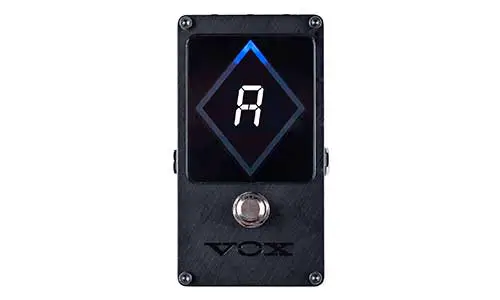
Vox has been creating a lot of hardware and the VXT-1 is their first tuner. With this device, you get the best of both worlds; highly detailed strobe tuning along with excellent accuracy of +/- 0.2 per cent.
This tuner also has a number of features that make it ideal for a variety of instruments including deep bass stringed instruments. On the front, you get a very big and bright LED screen with a ‘Diamond Visual Meter.’
The diamond-shaped display is fitted with a nice bright note indicator together with a multi-LED note meter to show you exactly where you need to tighten/loosen things to get the right tune.
As you toggle through the menu, you will also find a long list of offset tuning modes for certain instruments and also the ability to customize the tuning of your own instrument to meet your resonance requirements.
You can also customize the display and change between strobe mode, diamond mode and vertical display mode. For the highest accuracy, the strobe mode will be the best choice.
Even though this is a large device, Vox claims that it can run continuously for 24 hours on a single 9V battery. This device also has power output options on one side so you can easily hook it up to a pedal board and power other devices as well.
The power output is 200mA which is enough for most pedals you will want to use. Everything comes together in a solid aluminium box to give you excellent durability.
Here is a great video about the VXT-1 tuner.
| Pros | Cons |
| Very high accuracy | The menu is a bit confusing |
| Plenty of tuning options | |
| Customizable features |
Why you Need A Tuner Pedal; Advantages of Tuner Pedals Over other Tuners
Bass guitars can be tuned in a few different ways including using clip-on tuners, rack tuners, tuning forks or even just by ear. However, tuning pedals are the preferred method by most performers and professional musicians.
There are a few reasons why you should also consider pedal tuners as opposed to the other options. Firstly, pedal tuners are extremely convenient. You have your guitar physically plugged into the tuner and it is always on while you are playing.
On the contrary, tuning by ear, using a clip-on tuner or even using tuning forks, doesn’t create a physical or electronic connection with the tuning device.
When you are on stage, or even in a slightly noisy environment, the tuner that is relying purely on soundwaves from the guitar will also be picking up sound from the environment and this will naturally taint the audio quality.
Moreover, it’s not always possible to get yourself or your guitar in the right position in front of the tuner to get the tuning done correctly. Perhaps the most inconvenient, even for the casual player just playing at home, is the fork tuners.
The best way to use these is to have someone else help you with the setup so you can get them to work correctly and this isn’t always possible, especially when you are performing on stage.
In terms of accuracy, pedal tuners are again much better than other options. While fork tuners are considered the benchmark for audio tuning, that is only possible in a lab-like environment where you can isolate every other sound except the resonance from the instrument itself.
Moreover, different bass guitars will respond differently to the same tuner so it can be quite cumbersome to use these.
In the past, pedal tuners have been inaccurate but the latest tuners (many from the list above) have an accuracy of 0.5% or better.
Even when you play through large speakers and at high volumes, it is next to impossible for someone to be able to pick up a tuning variation of such an acute margin. In reality, human hearing simply isn’t that sensitive to tuning frequencies.
Rack tuners are a great option when it comes to accuracy but again they are mostly used in studio settings where there is an audio rack for each musician and everyone is comfortable in their spot.
When you are performing, and especially if you are travelling, it just isn’t convenient to be lugging around a big, heavy rack tuner and trying to set it up on stage to use every few minutes to make sure you are in tune.
Lastly, the price of the tuner. Today, pedal tuners are far more affordable than they used to be and they are certainly more affordable than other high-quality options like rack tuners.
Not to mention that pedal tuners also have the ability to power other pedals on your pedalboard. In fact, some even come with a battery bank so you don’t really need a PSU at all. Clip-on tuners, rack-mounted tuners and other options don’t grant you this kind of luxury.
Also, if you are looking for an all-in-one option, for instance, a tuner with multiple tuning capabilities as well as chromatic and polyphonic features, you will have to look at a pedal tuner since other tuners don’t offer this blend of features.
A Note on Tuning Accuracy
When tuning your guitar, or any instrument for that matter, you should certainly tune to 100% of the tuner you are using. However, the accuracy of that tuner itself, in terms of the harmonic resonance accuracy of the tuner, is a separate matter altogether.
There are 100 cents in a semitone. When you are using a tuner with an accuracy of 0.5 per cent accuracy, you could be up or below the right tune by half a cent.
For the average person, it can be hard to aurally judge the difference between an entire semitone, especially when you are listening to a performer who is playing alongside a number of other instruments and vocals.
Seasoned musicians or people who have really heard a lot of studio-quality music or those that naturally have perfect pitch may be able to detect a difference of even 3-4 cents in a semitone but again this would require a lot of focus and it would be much harder to detect this in a live performance.
Generally, an accuracy of more than 2 per cent will be inaudible to 95% of the audience, and even the musicians playing the instrument. However, whatever setting you set on your tuner, it is important that you get that tuning 100% according to the tuner you are using.
When the Music is Not 440hz – What to Do
440hz is considered the standard for instrument tuning around the world. This is seen as the standard tuning for A above middle C, and it is the setting at which nearly all tuners are set from the factory.
The purpose of this is so that all instruments can be tuned according to one harmonic ‘standard’. This way if you have a bass guitar, a piano, and an electric guitar all playing the same note at the same frequency, they will all have the same resonance. They will all sound in tune.
There are some tuners that will allow you to adjust the tuning frequency to meet your needs. The most common alternative is Verdi’s A, in which A is 432 Hz. If you want to play at different tuning frequencies then you should invest in a tuner that allows this flexibility.
There are a number of tuners that can go down to 430 Hz or even as high as 450 Hz. However, if you have a tuner that doesn’t allow frequency changes you can be sure that it is most likely set at 440 Hz.
Tuners that do have this feature will demonstrate how you can change the frequency in the manual or you can look online to see how to change the frequency on your particular tuner.
Conclusion
If you want to play your bass guitar to its full potential, investing in a quality pedal tuner will be worth every penny. A good quality tuner will easily last you several years and give you all the flexibility and the options to explore your instrument and your musical talent.
Before getting a tuner, explore what kind of features you want and also look at whether you want to connect more pedals with it or not. If you just want to get your guitar on the right notes then even a small travel-friendly tuner will do the job.


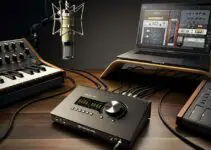
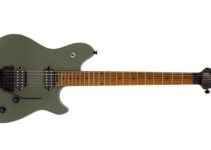
![Hi-Z vs Lo-Z [PRACTICAL Case Scenarios Covered]](https://performerlife.com/wp-content/uploads/2022/05/microphone-211x150.jpg)
